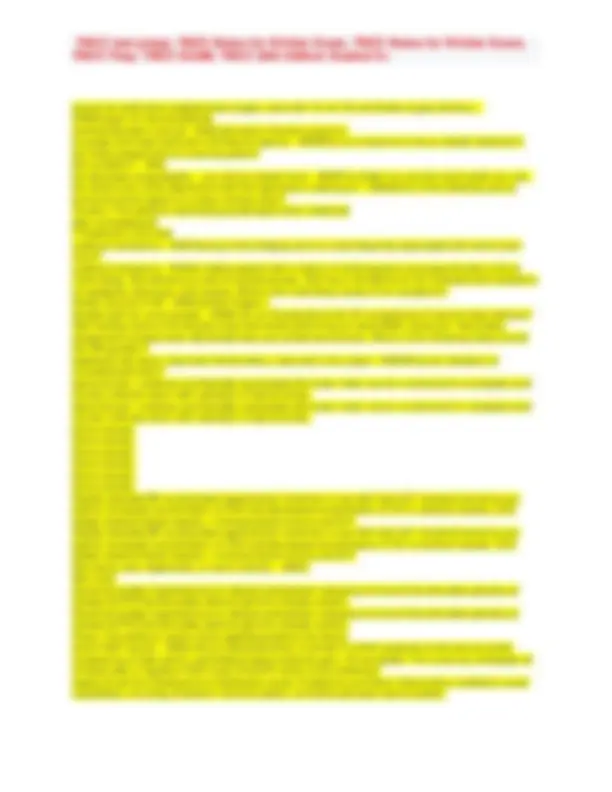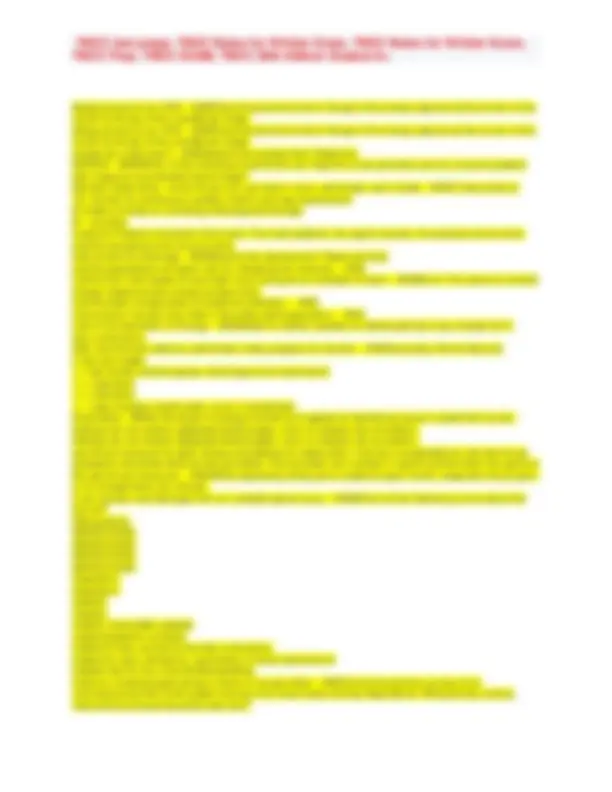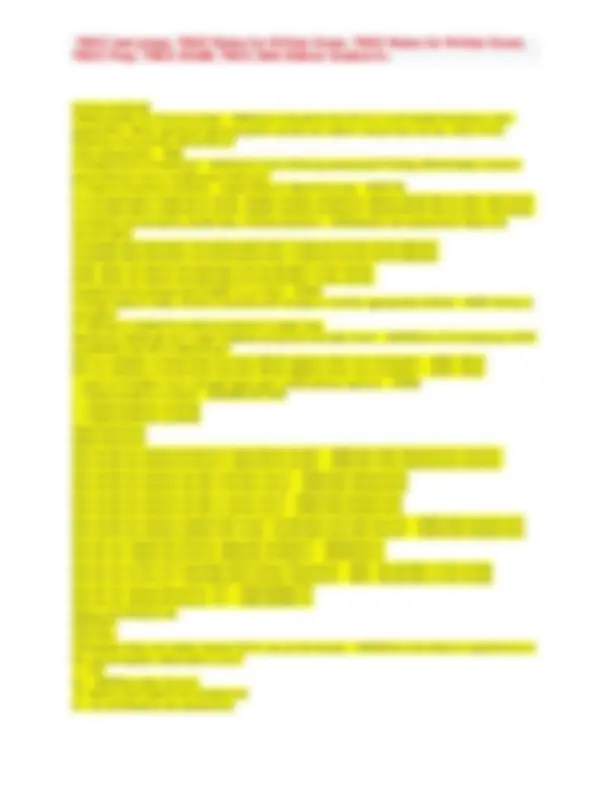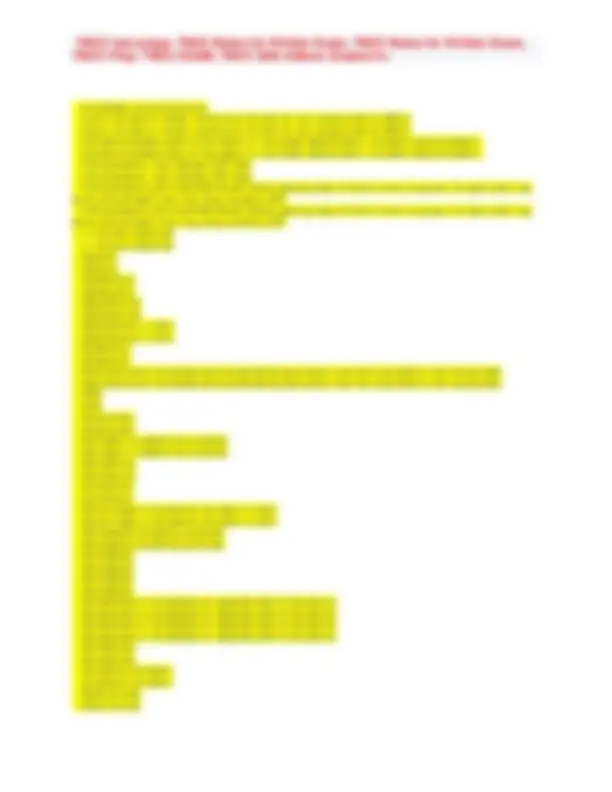

















































Study with the several resources on Docsity

Earn points by helping other students or get them with a premium plan


Prepare for your exams
Study with the several resources on Docsity

Earn points to download
Earn points by helping other students or get them with a premium plan
Community
Ask the community for help and clear up your study doubts
Discover the best universities in your country according to Docsity users
Free resources
Download our free guides on studying techniques, anxiety management strategies, and thesis advice from Docsity tutors
TNCC test prepa, TNCC Notes for Written Exam, TNCC Notes for Written Exam, TNCC Prep, TNCC EXAM, TNCC 20th Edition Graded A+ - for merge.pdf
Typology: Exams
1 / 55

This page cannot be seen from the preview
Don't miss anything!
















































worsening pneumothorax - ANSWhich of the following is possible complication of positive-pressure ventilation? within 24 hrs of trauma - ANSWhen is the tertiary survey completed fora trauma pt? With any eye injury, what should the evaluation and ongoing assessments be? - ANS- Reassessing visual acuity at reasonable intervals With any eye injury, what should the evaluation and ongoing assessments be? - ANS- Reassessing visual acuity at reasonable intervals Why does herniation occur? What are the symptoms? - ANSBecause of uncontrolled increases in ICP. Why does herniation occur? What are the symptoms? - ANSBecause of uncontrolled increases in ICP. Which comorbid conditions factor into the risks of the bariatric trauma patient? And how? - ANS Where do you listen to auscultate breath sounds? - ANSAuscultate the lungs bilaterally at the second intercostal space midclavicular line and at the fifth intercostal space at the anterior axillary line. Where do you listen to auscultate breath sounds? - ANSAuscultate the lungs bilaterally at the second intercostal space midclavicular line and at the fifth intercostal space at the anterior axillary line. When would you use a nasopharyngeal airway versus an oral pharyngeal airway? - ANSNasopharyngeal airways is contraindicated in patients with facial trauma or a suspected basilar skull fracture. Oral pharyngeal airways is used in unresponsive patients unable to maintain their airway, without a gag reflex as a temporary measure to facilitate ventilation with a bag mask device or spontaneous ventilation until the patient can be intubated. When would you use a nasopharyngeal airway versus an oral pharyngeal airway? - ANSNasopharyngeal airways is contraindicated in patients with facial trauma or a suspected basilar skull fracture. Oral pharyngeal airways is used in unresponsive patients unable to maintain their airway, without a gag reflex as a temporary measure to facilitate ventilation with a bag mask device or spontaneous ventilation until the patient can be intubated. When capnography measurement reads less than 35MMHG, the nurse should consider increasing or decreasing the ventilation rate? - ANSDecreasing the ventilation rate. By doing so, the nurse allows the patient to retain CO2. When capnography measurement reads less than 35MMHG, the nurse should consider increasing or decreasing the ventilation rate? - ANSDecreasing the ventilation rate. By doing so, the nurse allows the patient to retain CO2. When capnography measurement reads greater than 45MMHG, the nurse should consider increasing or decreasing the ventilation rate? - ANSIncreasing the ventilation rate. Doing so would allow the patient to blow off retained CO2. When capnography measurement reads greater than 45MMHG, the nurse should consider increasing or decreasing the ventilation rate? - ANSIncreasing the ventilation rate. Doing so would allow the patient to blow off retained CO2. What she be done after the Secondary Assessment? - ANSReassess: What she be done after the Secondary Assessment? - ANSReassess: What medications are used during intubation? - ANSLOAD Mnemonic: What medications are used during intubation? - ANSLOAD Mnemonic: What is vascular response? - ANSAs blood volume decreases, peripheral blood vessels vasoconstrict as a result of sympathetic stimulation via inhibition of baroreceptors. Arterioles constrict to increase TPR and BP. What is vascular response? - ANSAs blood volume decreases, peripheral blood vessels vasoconstrict as a result of sympathetic stimulation via inhibition of baroreceptors. Arterioles constrict to increase TPR and BP. What is torsion? - ANSTorsion forces twist ends in opposite directions. What is torsion? - ANSTorsion forces twist ends in opposite directions. What is the trauma triad of death? - ANShypothermia, acidosis, coagulopathy What is the trauma triad of death? - ANShypothermia, acidosis, coagulopathy What is the second thing assessed under the Secondary Assessment? - ANSGIVE COMFORT MEASURES
What is the second thing assessed under the Secondary Assessment? - ANSGIVE COMFORT MEASURES What is the relationship between mass and velocity to kinetic energy? - ANSKinetic energy is equal to 1/ the mass multiplied the square of its velocity therefore when mass is doubled so is the net energy, however, when velocity is doubled energy is quadrupled. What is the relationship between mass and velocity to kinetic energy? - ANSKinetic energy is equal to 1/ the mass multiplied the square of its velocity therefore when mass is doubled so is the net energy, however, when velocity is doubled energy is quadrupled. What is the recommended fluid bolus for a trauma? - ANS500 ML's of warmed isotonic crystalloid. Ongoing fluid boluses of 500 ML's should be given judiciously with constant reassessments after administration. What is the recommended fluid bolus for a trauma? - ANS500 ML's of warmed isotonic crystalloid. Ongoing fluid boluses of 500 ML's should be given judiciously with constant reassessments after administration. What is the planning and implementation for thoracic injury? - ANSp. 142 What is the planning and implementation for thoracic injury? - ANSp. 142 What is the Munro-Kellie doctrine? - ANSWithin the skull 80% his brain, 10% is blood, and 10% is CSF. Any increase of any of the products results in increased intracranial pressure. What is the Munro-Kellie doctrine? - ANSWithin the skull 80% his brain, 10% is blood, and 10% is CSF. Any increase of any of the products results in increased intracranial pressure. What is the Mnemonic for the Secondary Assessment? - ANSF = Full set of VS/Focused adjuncts (includes cardiac monitor, urinary catheter, and gastric tube)/Family presence What is the Mnemonic for the Secondary Assessment? - ANSF = Full set of VS/Focused adjuncts (includes cardiac monitor, urinary catheter, and gastric tube)/Family presence What is the Mnemonic for the Initial Assessment? - ANSA = Airway with simultaneous cervical spine protection What is the Mnemonic for the Initial Assessment? - ANSA = Airway with simultaneous cervical spine protection What is the minimum permissive oxygenation level of a trauma patient? - ANSGreater than or equal to 94% What is the minimum permissive oxygenation level of a trauma patient? - ANSGreater than or equal to 94% What is the minimum permissive hypertension and a trauma patient? - ANSA systolic of greater than or equal to 90 MMHG What is the minimum permissive hypertension and a trauma patient? - ANSA systolic of greater than or equal to 90 MMHG What is the Law of Conservation of Energy? - ANSEnergy can neither be created nor destroyed. It is only changed from one form to another. What is the Law of Conservation of Energy? - ANSEnergy can neither be created nor destroyed. It is only changed from one form to another. What is the first thing assessed under the Secondary Assessment? - ANSFULL SET VS / FOCUSED ADJUNCTS / FAMILY PRESENCE What is the first thing assessed under the Secondary Assessment? - ANSFULL SET VS / FOCUSED ADJUNCTS / FAMILY PRESENCE What is the DOPE mnemonic? - ANSD - Displaced tube What is the DOPE mnemonic? - ANSD - Displaced tube What is tension? - ANSstretching force by pulling at opposite ends What is tension? - ANSstretching force by pulling at opposite ends What is Surgical Cricothyrotomy? - ANSMaking an incision in cricothyroid membrane and placing a cuffed endo or trach tube into trachea. This is indicated when other methods of airway management have failed and pt cannot be adequately ventilated and oxygenated.
What is Cushing's phenomenon or Cushing's Reflex? - ANSTriad of progressive HTN, bradycardia and diminished respiratory effort. What is Cullen's sign and its significance? - ANSCullens sign is periumbilical bruising and is indicative of intraperitoneal bleeding What is Cullen's sign and its significance? - ANSCullens sign is periumbilical bruising and is indicative of intraperitoneal bleeding What is compression? - ANSCrushing by squeezing together What is compression? - ANSCrushing by squeezing together What is combined loading? - ANSAny combination of tension compression torsion bending and/or shear. What is combined loading? - ANSAny combination of tension compression torsion bending and/or shear. What is bending? - ANSLoading about an axis. Bending causes compression on the side the person is bending toward intention to the opposite side What is bending? - ANSLoading about an axis. Bending causes compression on the side the person is bending toward intention to the opposite side What is assessed under the Mnemonic "I"? - ANSINSPECT POSTERIOR SURFACES What is assessed under the Mnemonic "I"? - ANSINSPECT POSTERIOR SURFACES What is assessed under the Mnemonic "H"? - ANSHISTORY / HEAD-TO-TOE ASSESSMENT What is assessed under the Mnemonic "H"? - ANSHISTORY / HEAD-TO-TOE ASSESSMENT What is assessed and intervened for Expose/Environmental Controls? - ANS- Remove clothing What is assessed and intervened for Expose/Environmental Controls? - ANS- Remove clothing What is an epidural hematoma and its S/S? - ANSResults when a collection of blood forms between the skull and the dura mater. Bleeding is arterial=blood accumulates rapidly: What is an epidural hematoma and its S/S? - ANSResults when a collection of blood forms between the skull and the dura mater. Bleeding is arterial=blood accumulates rapidly: What is a trademark symptom of an epidural hematoma - ANSLoss of consciousness then awake and alert then loss of consciousness What is a trademark symptom of an epidural hematoma - ANSLoss of consciousness then awake and alert then loss of consciousness What is a subdural hematoma and its S/S? - ANSA focal brain injury beneath the dura mater that results from acceleration/deceleration. Usually venous, and not necessarily from a fx. Formation may be acute or chronic. What is a subdural hematoma and its S/S? - ANSA focal brain injury beneath the dura mater that results from acceleration/deceleration. Usually venous, and not necessarily from a fx. Formation may be acute or chronic. What is a pulmonary contusion? - ANSThey occur as a result of direct impact, deceleration or high- velocity bullet wounds. It develops when blood leaks into lung parenchyma, causing edema + hemorrhage. This usually develops overtime and not immediately. What is a pulmonary contusion? - ANSThey occur as a result of direct impact, deceleration or high- velocity bullet wounds. It develops when blood leaks into lung parenchyma, causing edema + hemorrhage. This usually develops overtime and not immediately. What is a Laryngeal Mask Airway? - ANSLooks like an ET tube but is equipped with an inflatable, elliptical, silicone rubber collar at the distal end. It is designed to cover the supraglottic area. What is a Laryngeal Mask Airway? - ANSLooks like an ET tube but is equipped with an inflatable, elliptical, silicone rubber collar at the distal end. It is designed to cover the supraglottic area. What is a flail chest? - ANSA fracture of two or more sites on two or more adjacent ribs, or when rib fractures produce a free-floating sternum. What is a flail chest? - ANSA fracture of two or more sites on two or more adjacent ribs, or when rib fractures produce a free-floating sternum. What is a concussion and its signs and symptoms? - ANSA temporary change in neurologic function that may occur as a result of minor head trauma. What is a concussion and its signs and symptoms? - ANSA temporary change in neurologic function that may occur as a result of minor head trauma.
What is a Combitube? - ANSA dual-lumen, dual-cuff airway that can be placed blindly into the esophagus to establish an airway. If inadvertently placed into trachea, it can be used as a temporary ET tube. There are only two sizes: small adult and larger adult. What is a Combitube? - ANSA dual-lumen, dual-cuff airway that can be placed blindly into the esophagus to establish an airway. If inadvertently placed into trachea, it can be used as a temporary ET tube. There are only two sizes: small adult and larger adult. What is a cerebral contusion and its S/S? - ANSA common focal brain injury in which brain tissue is bruised and damaged in a local area. Mainly located in frontal and temporal lobes. May cause hemorrhage, infarction, necrosis and edema. Max effects of bleeding & edema peak 18-36 post injury. What is a cerebral contusion and its S/S? - ANSA common focal brain injury in which brain tissue is bruised and damaged in a local area. Mainly located in frontal and temporal lobes. May cause hemorrhage, infarction, necrosis and edema. Max effects of bleeding & edema peak 18-36 post injury. What intervention should be done if a pt presents with effective circulation? - ANS- Insert 2 large caliber IV's What intervention should be done if a pt presents with effective circulation? - ANS- Insert 2 large caliber IV's What intervention is used to treat hypotension from aortocaval compression? - ANS What happens to a ruptured diaphragm? - ANSPotentially life-threatening, results from forces that penetrate the body. Left hemidiaphragm is more susceptible to injury because the right side is protected by the liver. What happens to a ruptured diaphragm? - ANSPotentially life-threatening, results from forces that penetrate the body. Left hemidiaphragm is more susceptible to injury because the right side is protected by the liver. What cues to abuse may be obtained during the history portion of the initial assessment? - ANS What could a flail chest be associated with? - ANS- Ineffective ventilation What could a flail chest be associated with? - ANS- Ineffective ventilation What condition is associated with a fall from which the older adult cannot rise? What complications result from What causes the tertiary effects of blast traumas? - ANSResults from individuals being thrown by the blast wind. Injuries include hole or partial body translocation from being thrown against a hard service: blunt or penetrating trauma's, fractures, traumatic amputations. What causes the tertiary effects of blast traumas? - ANSResults from individuals being thrown by the blast wind. Injuries include hole or partial body translocation from being thrown against a hard service: blunt or penetrating trauma's, fractures, traumatic amputations. What causes the secondary effects of blast traumas? - ANSProjectiles propelled by the explosion. Injuries include penetrating or blunt injuries or I penetration. What causes the secondary effects of blast traumas? - ANSProjectiles propelled by the explosion. Injuries include penetrating or blunt injuries or I penetration. What causes the primary effects of blast traumas? - ANSThe direct blast effects. Types of injuries include last long, tympanic membrane rupture and middle ear damage, abdominal hemorrhage and perforation, global rupture, mild Trumatic brain injury. What causes the primary effects of blast traumas? - ANSThe direct blast effects. Types of injuries include last long, tympanic membrane rupture and middle ear damage, abdominal hemorrhage and perforation, global rupture, mild Trumatic brain injury. What causes quinary effects of blasts traumas? - ANSThose associated with exposure to hazardous materials from radioactive, biologic, or chemical components of a blast. Injuries include a variety of health effects depending on agent. What causes quinary effects of blasts traumas? - ANSThose associated with exposure to hazardous materials from radioactive, biologic, or chemical components of a blast. Injuries include a variety of health effects depending on agent. What causes quarternary effects of blast traumas? - ANSAll explosion related injuries, illnesses, or diseases not due to the first three mechanisms. Injuries include external and internal burns, crush injuries,
respiratory rate, pale cool and clammy skin, kidney liver and other organ failure, severe acidosis, elevated lactic acid levels, worsening base access on ABGs, coagulopathies with petechiae purpura or bleeding. What are the signs and symptoms of irreversible shock? - ANSObtunded stuporous or comatose state, marked hypertension and heart failure, bradycardia with possible dysrhythmias, decreased and shallow respiratory rate, pale cool and clammy skin, kidney liver and other organ failure, severe acidosis, elevated lactic acid levels, worsening base access on ABGs, coagulopathies with petechiae purpura or bleeding. What are the signs and symptoms of decompensated shock? - ANSDecreased level of consciousness, hypertension, narrow pulse pressure, tachycardia with weak pulses, tachypnea, skin that is cool clammy and cyanotic, base access outside the normal range, and serum lactate levels greater than two to 4MMOL/L. What are the signs and symptoms of decompensated shock? - ANSDecreased level of consciousness, hypertension, narrow pulse pressure, tachycardia with weak pulses, tachypnea, skin that is cool clammy and cyanotic, base access outside the normal range, and serum lactate levels greater than two to 4MMOL/L. What are the seven patterns of pathway injuries related to motor vehicle accidents? - ANSUp and over, down and under, lateral, rotational, rear, roll over, and ejection. What are the seven patterns of pathway injuries related to motor vehicle accidents? - ANSUp and over, down and under, lateral, rotational, rear, roll over, and ejection. What are the S/S of pulmonary contusion? - ANS- Dyspnea What are the S/S of pulmonary contusion? - ANS- Dyspnea What are the S/S of pericardial tamponade? - ANSA collection of blood in pericardial sac. As blood accumulates, it exerts pressure on the heart, inhibiting or compromising ventricular filling. What are the S/S of pericardial tamponade? - ANSA collection of blood in pericardial sac. As blood accumulates, it exerts pressure on the heart, inhibiting or compromising ventricular filling. What are the S/S of orbital fracture (orbital blowout fracture)? - ANS- Diplopia (double vision) What are the S/S of orbital fracture (orbital blowout fracture)? - ANS- Diplopia (double vision) What are the S/S of Hemothorax? - ANS- Dyspnea, tachypnea What are the S/S of Hemothorax? - ANS- Dyspnea, tachypnea What are the S/S of flail chest? - ANS- Dyspnea What are the S/S of flail chest? - ANS- Dyspnea What are the S/S of a tension pneumothorax? - ANS- Severe respiratory distress What are the S/S of a tension pneumothorax? - ANS- Severe respiratory distress What are the S/S of a pneumothorax? - ANS- Dyspnea, tachypnea What are the S/S of a pneumothorax? - ANS- Dyspnea, tachypnea What are the S/S of a linear skull fx? - ANS- H/A What are the S/S of a linear skull fx? - ANS- H/A What are the S/S of a depressed skull fx? - ANS- H/A What are the S/S of a depressed skull fx? - ANS- H/A What are the S/S of a basilar skull fx? - ANS- H/A What are the S/S of a basilar skull fx? - ANS- H/A What are the Rapid Sequence Intubation Steps? - ANSPREPARATION: What are the Rapid Sequence Intubation Steps? - ANSPREPARATION: What are the nursing interventions for a pt with an ocular injury? - ANS- Assess visual acuity & reassess What are the nursing interventions for a pt with an ocular injury? - ANS- Assess visual acuity & reassess What are the nursing interventions for a patient with a maxillofacial or neck injury? - ANS- Administer oxygen What are the nursing interventions for a patient with a maxillofacial or neck injury? - ANS- Administer oxygen What are the most common type of injury associated with chest trauma? - ANSblunt; MVC's. Penetrating; firarm injuries or stabbings What are the most common type of injury associated with chest trauma? - ANSblunt; MVC's. Penetrating; firarm injuries or stabbings What are the mandibular fracture S/S? - ANS- Malocclusion
What are the mandibular fracture S/S? - ANS- Malocclusion What are the late signs of Increased intracranial pressure - ANSdilated, non-reactive pupil(s); abnormal motor posturing (flexion, extension, flaccidity); Cushing's triad, Unresponsive to per verbal and painful stimuli, bradycardia and decreased respiratory effort What are the late signs of Increased intracranial pressure - ANSdilated, non-reactive pupil(s); abnormal motor posturing (flexion, extension, flaccidity); Cushing's triad, Unresponsive to per verbal and painful stimuli, bradycardia and decreased respiratory effort What are the late signs of breathing compromise? - ANS- Tracheal deviation What are the late signs of breathing compromise? - ANS- Tracheal deviation What are the late observable signs of symptoms of increased ICP? - ANS- Dilated, nonreactive pupil What are the late observable signs of symptoms of increased ICP? - ANS- Dilated, nonreactive pupil What are the interventions for Effective/Ineffective Circulation? - ANS- Control any uncontrolled external bleeding by: What are the interventions for Effective/Ineffective Circulation? - ANS- Control any uncontrolled external bleeding by: What are the interventions for Disability? - ANS- If assessment indicates a decreased LOC, conduct further investigation during secondary focused assessments What are the interventions for Disability? - ANS- If assessment indicates a decreased LOC, conduct further investigation during secondary focused assessments What are the greatest risks for transport? - ANSLoss of airway patency, displaced obstructive tubes lines or catheters, dislodge splinting devices, need to replace or reinforce dressings, deterioration in patient status change in vital signs or level of consciousness, injury to the patient and/or team members What are the greatest risks for transport? - ANSLoss of airway patency, displaced obstructive tubes lines or catheters, dislodge splinting devices, need to replace or reinforce dressings, deterioration in patient status change in vital signs or level of consciousness, injury to the patient and/or team members What are the four types of trauma related injuries? - ANSBlunt, penetrating, thermal, or blast. What are the four types of trauma related injuries? - ANSBlunt, penetrating, thermal, or blast. What are the four types of shock? - ANSHypovolemic, Cardiogenic, Obstructive, & Distributive What are the four types of shock? - ANSHypovolemic, Cardiogenic, Obstructive, & Distributive What are the five forms in which energy exist? - ANS1. Mechanical What are the early signs of increased Intracranial pressure - ANSheadache, vomiting, behavioral changes that begin with restlessness and may progress to confusion, drowsiness, or impaired judgment What are the early signs of increased Intracranial pressure - ANSheadache, vomiting, behavioral changes that begin with restlessness and may progress to confusion, drowsiness, or impaired judgment What are the early signs and symptoms of increased ICP? - ANS- Headache What are the early signs and symptoms of increased ICP? - ANS- Headache What are signs of ineffective circulation? - ANS- Tachycardia What are signs of ineffective circulation? - ANS- Tachycardia What are signs of ineffective breathing? - ANS- AMS What are signs of ineffective breathing? - ANS- AMS What are signs of a serious eye injury? - ANS- Visual disturbances What are signs of a serious eye injury? - ANS- Visual disturbances What are S/S with tracheobronchial injury? - ANSBlunt trauma. "Clothesline-type" injuries. What are S/S with tracheobronchial injury? - ANSBlunt trauma. "Clothesline-type" injuries. What are S/S with blunt cardiac injury? - ANS"Cardiac contusion" or "concussion." Common with MVC or falls from heights. What are S/S with blunt cardiac injury? - ANS"Cardiac contusion" or "concussion." Common with MVC or falls from heights. What are S/S of penetrating trauma/open or ruptured globe? - ANS- Marked visual impairments What are S/S of penetrating trauma/open or ruptured globe? - ANS- Marked visual impairments What are s/s of chemical burns to the eye? - ANSChemical injuries require immediate intervention if it is to be preserved.
trauma its need early supplemental oxygen, start with 15 mL O2 and titrate oxygen delivery. - ANSOxygen on trauma patients tracheal deviation and jvd - ANSLate signs of tension pneumo: to guage end-organ perfusion and tissue hypoxia - ANSWhy is a measure of serum lactate obtained in the initial assessment of a trauma patient? this condition? - ANS the decrease coagulopathy .. you will you bleed more - ANSThe colder you are the more acidic you are.. the aorta is torn at its attachment with the ligamentum arteriosum - ANSwhich of the following occurs during the third impact of a motor vehicle crash? Tension: The ability to resist being pulled apart when stretched take out backboard T treatment in the field subdural hematoma - ANSTearing of the bridging veins is most frequently associated with which brain injury? subdural hematoma - ANSAn elderly patient with a history of anticoagulant use presents after a fall at home today. She denies any loss of consciousness. She has a hematoma to her forehead and complains of headache, dizziness, and nausea. What is the most likely cause of her symptoms? Stroke Volume X HR - ANSCardiac Output = straight cath for urine sample - ANSA 20 y/o M presents to the ED complaining of severe lower abd pain after landing hard on the bicycle cross bars while preforming an aerial BMX maneuver. Secondary assessment reveals lower abd tenderness and scrotal ecchymosis. Which of the following orders would the RN question? stabilized vital signs, improved mental status, improved urine output - ANSWhat are indicators of increased perfusion? Spinal shock = areflexia and flaccidity associated with lower motor neuron involvement in complete cord injuries; reflexes return with resolution of spinal shock. Spinal shock = areflexia and flaccidity associated with lower motor neuron involvement in complete cord injuries; reflexes return with resolution of spinal shock. Some causes: Some causes: Some causes: Some causes: Some causes: Some causes: Slightly elevated BP could protect against brain ischemia in a pt with high ICP. Cerebral ischemia can lead to increased concentration of CO2 and decreased concentration of O2 in cerebral vessels. CO dilates cerebral blood vessels = increase blood volume and ICP. Slightly elevated BP could protect against brain ischemia in a pt with high ICP. Cerebral ischemia can lead to increased concentration of CO2 and decreased concentration of O2 in cerebral vessels. CO dilates cerebral blood vessels = increase blood volume and ICP. Skin temp: cool, diaphoretic, or warm and dry - ANSC Skin color Shock stimulates hypothalamus to release corticotropin-releasing hormone that stimulates pituitary to release ACTH that stimulates adrenal gland to release cortisol. Shock stimulates hypothalamus to release corticotropin-releasing hormone that stimulates pituitary to release ACTH that stimulates adrenal gland to release cortisol. Shear: The ability to resist a force applied parallel to the tissue serial FAST exams - ANSa 49 y/o restrained driver involved in a MVC presents to the trauma center complaining of abd, pelvic, and bilateral lower extremity pain. VS are stable. The nurse can anticipate all of these after a negative FAST exam EXCEPT which of the following? Septic shock from bacteremia is distributive shock. Endotoxins and other inflammatory mediators cause vasodilation, shunting of blood in microcirculation, and other perfusion abnormalities.
Septic shock from bacteremia is distributive shock. Endotoxins and other inflammatory mediators cause vasodilation, shunting of blood in microcirculation, and other perfusion abnormalities. Septic Shock - systemic release of bacterial endotoxins, resulting in increased vascular permeability and vasodilation. Neurogenic shock - spinal cord injury results of loss in sympathetic nervous system control of vascular tone. Sample is part of history S/S: S/S: S/S: S/S: S/S: S/S: S/S: S/S: S/S: S/S: S/S: S/S: S/S: S/S: S/S: S/S: S/S: S/S: S/S: S/S: S/S: S/S: S/E's S/E's S symptoms associated with injury S s/s in the field Review the age-related anatomic and physiologic change of the older adult in relation to the components of the Results from pump failure in the presence of adequate intravascular volume. There is a lack of cardiac output and end organ perfusion secondary to a decrease in myocardial contractility and/or valvular insufficiency. results from hypo perfusion to the tissue due to an obstruction in either vasculature or heart. Goal is to relieve obstruction and improve perfusion. Report your suspicion of maltreatment in accordance with local regulations - ANSa 5 y/o child presents to the ED with bruises to the upper arm and buttocks in various stages of healing and multiple small, clean, round burns to the back. There are no abnormalities found based on the pediatric assessment triangle or primary survey. Which of the following is the priority survey. Which of the following is the priority nursing intervention? reorganize care to C-ABC - ANSIf uncontrolled hemorrhage .. Renin causes angiotensinogen, normal plasma protein, to release angiotensin I. Renin causes angiotensinogen, normal plasma protein, to release angiotensin I. Remove all clothes and assess for any obvious injuries and uncontrolled bleeding - ANSE Reevaluation and Consider the need to Transfer - ANSFinal step in primary survey Rectal tone per MD - ANSI pulse oximetry and capnography - ANSWhat bedside monitoring parameters are used to assess for adequacy of O2 and effectiveness of ventilation?
Palpate trachea above suprasternal notch. Tracheal deviation may indicate a tension pneumothorax or massive hemothorax. palpate pelvis with high pressure over the iliac wings downward and medially - ANSHead to toe assessment: pelvis and perineum palpate for central pulses - carotid and femoral - rate, rhythm, and strength palate for depressions and tenderness Pain - ANSPost resuscitation care parameters that are continuously evaluated: padding the upper back while stabilizing the cervical spine - ANSCaregivers carry in a 2 y/o into the ED who fell out of a second-story window. The pt is awake and crying with increased work of breathing and pale skin. Which of the following interventions has the highest priority? P pneumothorax P past medical hx P = Pain P = Pain P - Pneumothorax: Condition may occur from original trauma or barotrauma from ventilator P - Pneumothorax: Condition may occur from original trauma or barotrauma from ventilator P - pain assessment and management - ANSG occurs as a result of maldistribution of an adequate circulating blood volume with the loss of vascular tone or increased permeability. Obtain Hx. Obtain Hx. O- oxygenation and ventilation analysis: Pulse oxygemetry and end-tidal caron dioxide (ETC02) monitoring and capnopgraphy O Oxygen and ETC02 monitors O obstructed or kinked O = Opioids O = Opioids O - Obstruction: Check secretions or pt biting tube O - Obstruction: Check secretions or pt biting tube Newton's Third Law of Motion - ANSFor every action there is an equal and opposite reaction Newton's Second Law of Motion - ANSThe acceleration of an object depends on the mass of the object and the amount of force applied. Newton's First Law of Motion - ANSan object in motion will remain in motion unless acted upon by another force Needle pericardiocentesis, but it is a temp solution. Requires surgical evaluation. nausea and vomiting - ANSWhich of the following is a late sign of increased intracranial pressure? narrowed - ANSWhich of the following pulse pressures indicate early hypovolemic shock? Name the three ways to confirm ETT placement - ANSPlacement of a CO2 monitoring device, Assessing for equal chest rise and fall, and listening at the epigastrium and four lung fields for equal breath sounds. Name the three ways to confirm ETT placement - ANSPlacement of a CO2 monitoring device, Assessing for equal chest rise and fall, and listening at the epigastrium and four lung fields for equal breath sounds. N- naso or orogastric tube consideration N - naso or oro gastric tubes Multiple requests for water - ANSEMS brings a pt who fell while riding his bicycle. Using the American College of Surgeobs screening guidelines, which assessment finding would prompt the RN to prepare the pt for a radiologic spine clearance? MOI Mitigation - ANSFollowing a review of recent drills and a real disaster event, a hospital has identified deficiencies and is taking steps to minimize the impact of a future disaster. Which phase of the disaster life cycle does this describe? MIST - prehospital report Mechanism of Injury - ANSIs how external forces are transferred to the body, resulting in injury
Measurement of an OPA - ANSPlace the proximal end or flange of the airway adjunct at the corner of the mouth to the tip of the mandibular angle. Measurement of an OPA - ANSPlace the proximal end or flange of the airway adjunct at the corner of the mouth to the tip of the mandibular angle. maybe do a fast scan? - ANSHead to toe assessment: Abdomen MARCH - ANSWhich of the following mnemonics can help the nurse prioritize care for a trauma patient with massive uncontrolled hemorrhage? Maintain body temp - cover the pt, turn up heat in room, administer warm fluids - ANSE Interventions: M- monitor for continuous cardiac rhythm and rate assessment M meds currently on including anticoagulant therapy M - monitors Looks at 4 factors involved in the event: The host (patient), the agent (cause), the physical evironment, and the socioeconomic environment. look at ears for drainage - ANSHead to toe assessment: Head and face List the populations at higher risk for interpersonal violence. - ANS List the four main types of traumatic injury and give an example of each - ANSBlunt: The result of a broad energy impact across a large surface area. List the basic components of evidence collection. - ANS List common injuries from falls in the older adult population. - ANS Law of Conservation of Energy - ANSMatter is neither created nor destroyed (but may change form) lacs, contusions, labs, wound care, tetanus, administer meds, prepare for transfer - ANSSecondary Reval Adjuncts L last oral intake L- Lab results (arterial gases, blood type and crossmatch) L = Lidocaine L = Lidocaine L - Labs (maybe a lactic acid), a b g 's, blood type Kinematics - ANSIs the study of energy transfer as it applies to identifying actual or potential injuries. Kidneys do not receive adequate blood supply, renin is release into circulation. Kidneys do not receive adequate blood supply, renin is release into circulation. jaw thrust maneuver to open airway and assess for obstruction. If pt has a suspected csi, the jaw thrust procedure should be done by two providers. One provider can maintain c-spine and the other can perform the jaw thrust maneuver. - ANSWhile assessing airway pt is unable to open mouth, responds only to pain, or is unresponsive you should.. it can worsen cord damage from an unstable spinal injury - ANSWhich of the following is true about the log-roll? Interventions INSPECTION: INSPECTION: INSPECTION: INSPECTION: Inspection: Inspection: Inspect: Inspect: inspect, auscultate, palpate inspect posterior surfaces inspect of lacs, puncture wounds, contusions, inspect for lacs, abrasions, asymmetry of facial expressions Inspect first for any uncontrolled bleeding insert an oropharyngeal airway if there is no gag reflex - ANSDuring the primary survey of an unconscious pt with multi-system trauma, the nurse notes snoring respirations. What priority nursing interventions should be preformed next?
H = Hx and Head-to-toe assessment Goal: Volume replacement and vasoconstriction - ANSDistributive Shock globe rupture - ANSA 35 y/o M presents with facial trauma after being struck in the face with a baseball. A teardrop-shaped left pupil is noted on exam. What type of injury is suspected? Get Resuscitation Adjuncts g. open pneumothoraces (sucking chest wounds) G = Give comfort measures (verbal reassurance, touch, and pharmacologic and nonpharmacologic management of pain). G = Give comfort measures (verbal reassurance, touch, and pharmacologic and nonpharmacologic management of pain). Full set of vitals and family presence - ANSF from hemorrhage is leading cause. Hypovolemia is caused by decrease in the amount of circulating volume. Goal is to replace volume. - ANSHypovolemic Shock flucuation in the water seal chamber - ANSWhich of the following is an expected finding in a pt with a tube thoracstomy connected to a chest drainage system? Flail segments may not be clinically evident in the first several hours after injury b/c of muscle spasms that cause splinting. After positive pressure intiated, paradoxical chest wall movement ceases. Flail segments may not be clinically evident in the first several hours after injury b/c of muscle spasms that cause splinting. After positive pressure intiated, paradoxical chest wall movement ceases. Flail chest - ANSParadoxical chest wall movement fat embolism - ANSa pt has been in the ED for several hrs waiting to be admitted. He sustained multiple rib fractures and a femur fracture after a fall. He has been awake, alert, and complaining of leg pain. His wife reported that he suddenly became anxious and confused. Upon reassessment, the pt is restless with respiratory distress and petechiae to his neck. The pt is exhibiting s/sx most commonly associated with which of the following conditions? f. contusions, abrasions, deformities (flail chest) Exposure and Environmental Control Explain Pulmonary Response. - ANSTachypnea happens for 2 reasons: Explain Pulmonary Response. - ANSTachypnea happens for 2 reasons: Explain Obstructive Shock. - ANSResults from inadequate circulating blood volume because of an obstruction or compression of great veins, aorta, pulmonary arteries, or heart itself. Explain Obstructive Shock. - ANSResults from inadequate circulating blood volume because of an obstruction or compression of great veins, aorta, pulmonary arteries, or heart itself. Explain Irreversible Shock. - ANSShock uncompensated or irreversible stages will cause compromises to most body systems. Explain Irreversible Shock. - ANSShock uncompensated or irreversible stages will cause compromises to most body systems. Explain Hypovolemic Shock. - ANSMost common to affect a trauma pt cause by hypovolemia.. Hypovolemia, a decrease in amount of circulating blood volume, may result from significant loss of whole blood because of hemorrhage or from loss of semipermeable integrity of cellular membrane leading to leakage of plasma and protein from intravascular space to the interstitial space (as in a burn). Explain Hypovolemic Shock. - ANSMost common to affect a trauma pt cause by hypovolemia.. Hypovolemia, a decrease in amount of circulating blood volume, may result from significant loss of whole blood because of hemorrhage or from loss of semipermeable integrity of cellular membrane leading to leakage of plasma and protein from intravascular space to the interstitial space (as in a burn). Explain Hepatic Response. - ANSLiver can store excess glucose as glycogen. Explain Hepatic Response. - ANSLiver can store excess glucose as glycogen. Explain Distributive Shock. - ANSResults from disruption in SNS control of the tone of blood vessels, which leads to vasodilation and maldistribution of blood volume and flow. (Neurogenic and Septic Shock). Neurogenic shock may result from injury to spinal cord in cervical or upper thoracic region. Explain Distributive Shock. - ANSResults from disruption in SNS control of the tone of blood vessels, which leads to vasodilation and maldistribution of blood volume and flow. (Neurogenic and Septic Shock). Neurogenic shock may result from injury to spinal cord in cervical or upper thoracic region.
Explain Cardiogenic Shock. - ANSSyndrome that results from ineffective perfusion caused by ineffective perfusion caused by inadequate contractility of cardiac muscle. Explain Cardiogenic Shock. - ANSSyndrome that results from ineffective perfusion caused by ineffective perfusion caused by inadequate contractility of cardiac muscle. Explain adrenal gland response. - ANSWhen adrenal glands are stimulated by SNS, release of catecholamines (epinephrine and norepinephrine) from adrenal medulla will increase. Explain adrenal gland response. - ANSWhen adrenal glands are stimulated by SNS, release of catecholamines (epinephrine and norepinephrine) from adrenal medulla will increase. Expedite transfer to the closest trauma center - ANSA 56 y/o M pt involved in a motor vehicle crash is brought to the ED of a rural critical access facility. He complains of neck pain, SOB, and diffuse abd pain. His GCS is 15. His VS: BP 98/71, HR 125, RR 26, SpO2 94% on high-flow O2 via NRB mask. Which of the following is the priority intervention for this patient? Ex: tension pneumo or cardiac tamponade are two classic examples that may result from trauma. - ANSObstructive Shock Ex: MI's or dysrhythmia are common causes - ANSCariogenic Shock Ex: Anaphylactic - release of antihistamines Epi stimulates receptors in heart to increase force of cardiac contraction (positive inotropy) and increase HR (positive chronotropy) to improve cardiac output, BP and tissue perfusion. Epi stimulates receptors in heart to increase force of cardiac contraction (positive inotropy) and increase HR (positive chronotropy) to improve cardiac output, BP and tissue perfusion. Ensure two large bore IVS are placed. endotracheal tube - ANSThe trauma nurse knows that placing a bariatric patient in a ramped position providers better visualization during the insertion of which device? elevating the extremity to the level of the heart - ANSA pt with a lower extremity fracture complains of severe pain and tightness in his calf, minimally by pain medications. Which of the following is the priority nursing intervention? elevate extremity Effect of cortisol release is elevation in blood sugar and increased insulin resistance and gluconeogenesis, hepatic process to produce more sugar. Effect of cortisol release is elevation in blood sugar and increased insulin resistance and gluconeogenesis, hepatic process to produce more sugar. e. skin color (normal, pale, flushed, cyanotic) E Events and environment factors related to the injury - ANSSAMPLE E equipment failure , such as becoming detached from the equipment or loss of capnopgrahy - ANSDOPE E = Expose/Environmental controls (remove clothing and keep the patient warm) E = Expose/Environmental controls (remove clothing and keep the patient warm) E - Equipment failure: pt may have become detached from equipment or there's a kink in the tubing E - Equipment failure: pt may have become detached from equipment or there's a kink in the tubing dysrhythmias - ANSPatients with a crush injury should be monitored for which of the following conditions? dressing removal - ANSA patient arrives with a large open chest wound after being assaulted with a machete. Prehospital providers placed a nonporous dressing over the chest wound and taped it on three sides. he is now showing signs of anxiety, restlessness, severe respiratory distress, cyanosis and decreasing blood pressure. Which of the following is the MOST appropriate immediate intervention? don't forget flanks!!! Disruptions of the bony structures of the skull can result in what? - ANSDisplaced or nondisplaced fx's causing CSF leakage b/c of lac to the dura mater, creating a passage for CSF. Disruptions of the bony structures of the skull can result in what? - ANSDisplaced or nondisplaced fx's causing CSF leakage b/c of lac to the dura mater, creating a passage for CSF. Discuss the use and insertion of nasogastric tubes in the bariatric patient. - ANS Disability - Neurologic Status Diminished BS: Diminished BS:
Describe the characteristics of hypovolemic shock - ANSHypovolemia is caused by a decrease in the amount of circulating volume usually caused by massive bleeding, but also can be from vomiting and diarrhea. Characteristics include low blood pressure and preload, increase heart rate respiratory rate and afterload, with contractility unchanged. Signs include obvious bleeding, weak peripheral pulses, pale cool and moist skin, distended abdomen, pelvic fracture, or bruise swollen and deformed extremities especially long bones. Describe the characteristics of distributive shock. - ANSDistributive shock occurs as a result of Mel distribution of an adequate circulating blood volume with the loss of vascular tone or increased permeability. This can occur with spinal cord injuries, sepsis, or anaphylaxis. Symptoms include low blood pressure heart rate respiratory rate preload and afterload, spinal tenderness, difficulty breathing, warm pink and dry skin with a cool core temperature. Describe the characteristics of distributive shock. - ANSDistributive shock occurs as a result of Mel distribution of an adequate circulating blood volume with the loss of vascular tone or increased permeability. This can occur with spinal cord injuries, sepsis, or anaphylaxis. Symptoms include low blood pressure heart rate respiratory rate preload and afterload, spinal tenderness, difficulty breathing, warm pink and dry skin with a cool core temperature. Describe the characteristics of cardiogenic shock - ANSCardiogenic shock results from pump failure in the presence of adequate intravascular volume. Lack of cardiac output and an organ perfusion occurs secondary to a decrease in myocardial contractility and or valvular insufficiency. This can happen with blunt cardiac trauma or an MI. Symptoms can include low blood pressure increase heart rate and respiratory rate chest pain shortness of breath dysrhythmias increase troponin and pale cool moist skin Describe the characteristics of cardiogenic shock - ANSCardiogenic shock results from pump failure in the presence of adequate intravascular volume. Lack of cardiac output and an organ perfusion occurs secondary to a decrease in myocardial contractility and or valvular insufficiency. This can happen with blunt cardiac trauma or an MI. Symptoms can include low blood pressure increase heart rate and respiratory rate chest pain shortness of breath dysrhythmias increase troponin and pale cool moist skin Describe the activities and associated factors related to low-energy trauma in the older adult. - ANS Describe the 3 types of Internal forces of energy transfer in the context of trauma. - ANSCompression: The ability of the tissue to resist crush injury or force Describe the 3 types of external forces of energy transfer in the context of trauma. - ANSDeceleration: Force from a sudden stop in the body's motion Describe techniques to improve the intubation process for the bariatric trauma patient. - ANS Describe steps to maintain the forensic chain of custody. - ANS Describe specific injuries associated with interpersonal violence and abuse. - ANS Describe one fat embolism syndrome is most likely to occur in its characteristics - ANSWith longform fractures. Tachycardia, Thrombocytopenia, and petechiae rash. Describe one fat embolism syndrome is most likely to occur in its characteristics - ANSWith longform fractures. Tachycardia, Thrombocytopenia, and petechiae rash. Describe effects of common medications in relation to the older adult trauma patient. - ANS Describe common patterns and severity of injuries in the bariatric trauma patient. - ANS defusings - ANSAll of these are considered a critical communication point in trauma care EXCEPT which of the following? Define uncal herniation. - ANSThe uncus (medial aspect of the temporal lobe) is displaced over the tentorium into the posterior fossa. This herniation is the more common of the two types of herniation syndromes. Define uncal herniation. - ANSThe uncus (medial aspect of the temporal lobe) is displaced over the tentorium into the posterior fossa. This herniation is the more common of the two types of herniation syndromes. Define the five mechanisms of injury in blast trauma. - ANS1. Primary: Found in patients who were closest to the blast. Injuries are most commonly associated with air-filled organs Define the characteristics of spinal shock - ANSTransient loss of function can include loss of reflexes and muscle tone below the level of industry with possible vascular response.
Define the characteristics of spinal shock - ANSTransient loss of function can include loss of reflexes and muscle tone below the level of industry with possible vascular response. Define the characteristics of neurogenic shock - ANSDistributive shock with a T6 or higher injury results and vasodilation, bradycardia, flushed warm dry skin. Risk for temperature instability. Nursing interventions include maintaining warmth and spinal stabilization. Define the characteristics of neurogenic shock - ANSDistributive shock with a T6 or higher injury results and vasodilation, bradycardia, flushed warm dry skin. Risk for temperature instability. Nursing interventions include maintaining warmth and spinal stabilization. Define tension pneumothorax. - ANSLife-threatening injury. Air enters pleural space on inspiration, but air cannot escape on expiration. Rising intrathoracic pressure collapses lung on side of injury causing a mediastinal shift that compresses the heart, great vessels, trachea and uninjured lung. Venous return impeded, cardiac output falls, hypotension results. Define tension pneumothorax. - ANSLife-threatening injury. Air enters pleural space on inspiration, but air cannot escape on expiration. Rising intrathoracic pressure collapses lung on side of injury causing a mediastinal shift that compresses the heart, great vessels, trachea and uninjured lung. Venous return impeded, cardiac output falls, hypotension results. Define Severe Head Trauma. - ANSPostresuscitative state with GCS score of 8 or less. Define Severe Head Trauma. - ANSPostresuscitative state with GCS score of 8 or less. Define Pneumothorax. - ANSResults when an injury to lung leads to accumulation of air in pleural space w/subsequent loss of negative intrapleural pressure. Partial or total collapse of lung may ensue. Define Pneumothorax. - ANSResults when an injury to lung leads to accumulation of air in pleural space w/subsequent loss of negative intrapleural pressure. Partial or total collapse of lung may ensue. Define Moderate Head Trauma - ANSPostresuscitative state with GCS 9-13. Define Moderate Head Trauma - ANSPostresuscitative state with GCS 9-13. Define Minor Head Trauma. - ANSGCS 13- 15 Define Minor Head Trauma. - ANSGCS 13- 15 Define Hemothorax. - ANSAccumulation of blood in the pleural space. Define Hemothorax. - ANSAccumulation of blood in the pleural space. Define Cushing's triad - ANSBradycardia, progressive hypertension (widening pulse pressure), and decreased respiratory effort Define Cushing's triad - ANSBradycardia, progressive hypertension (widening pulse pressure), and decreased respiratory effort Define central or transtentorial herniation. - ANSA downward movement of the cerebral hemispheres with herniation of the diencephalon and midbrain through the elongated gap of the tentorium. Define central or transtentorial herniation. - ANSA downward movement of the cerebral hemispheres with herniation of the diencephalon and midbrain through the elongated gap of the tentorium. d. use rapid infusion device - ANSC Interventions: d. signs of difficulty breathing such as accessory muscle use D displaced tube D = Disability (neurologic status) D = Disability (neurologic status) D = Defasiculating agents D = Defasiculating agents CSF leaks through the nose (rhinorrhea) or the ears (otorrhea). A potential entrance for invading bacteria. CSF leaks through the nose (rhinorrhea) or the ears (otorrhea). A potential entrance for invading bacteria. Countermeasures can be applied at each phase to help reduce injury. Cortisol also causes renal retention of water and sodium, a compensatory mechanism to conserve body water. Cortisol also causes renal retention of water and sodium, a compensatory mechanism to conserve body water. consider a tourniquet Consider a pelvic binder for pelvic fractures Compression: Force from being crushed between objects